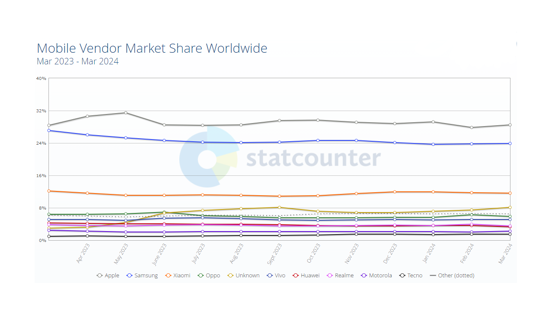It is a fact of our industry that the diversity of the digital ecosystem never stops growing.
According to statcounter.com, in the month of February 2024, 60% of all web traffic worldwide was performed on a mobile device. However, no mobile hardware producer could command even a 30% share of this market, with Apple having the highest share at 28%, and Samsung closely behind at 24%.

This widely open market leads to an interesting problem when it comes to how we support and test against a wide range of hardware, operating system and browser combinations. A user may decide to use any combination they wish and it is our responsibility in the Quality Assurance team to ensure that as many users as possible have seamless journeys when using our products.
It would not be physically possible to have on hand all the combinations we would like to test, based purely on the space they would take up. Add to that the time investment needed to keep them all updated and there would quickly be no time left to actually perform the testing. Therefore we need a service that provides us with these combinations at the click of a button and allows us to switch between them at ease, allowing us to test the combinations we need to cover as thoroughly as possible.
Founded in 2011, Browserstack gives us access to over 20,000 of these combinations. These aren’t emulators that give you an estimation of how a product will behave on a certain device or browser, but real devices running on the cloud. This has several benefits over having an in-house library of devices.
- Devices can be added to Browserstack on launch day. For example, the flagship iPhone 15 was available for use on Browserstack as soon as it was available to the public.
- New devices are being rolled out across the world all the time. Browserstack gives us access to these saving us the need to keep track of all the new releases and to constantly be shipping them in.
- The devices are kept up to date automatically. Across such a vast number of available devices the time saved here over updating in-house devices is monumental, and allows us to spend more time doing what we do best, testing and measuring the quality of our products, rather than troubleshooting updates.
- The logistical benefit of being able to access these devices at any time and from anywhere. If we’re visiting a client’s office and want to show them how our latest work looks on a Galaxy Z Fold 5, we can.
- By not having hundreds of devices constantly plugged in to be available when needed, and then having to dispose of them if they suffer any damage, there is also a very real environmental benefit too of opting for a cloud based solution

A look at how many iPhone combinations alone provides a glimpse of the scale of freedom provided to us to test on the devices and browsers used to access our products.
Browserstack’s features go beyond testing websites on devices- apps can be tested too! It wouldn’t be very useful to wait for a new app to be reviewed and approved to go onto the app store before we could even start testing it, so instead we can upload our apps straight to Browserstack and test there, finding and fixing any issues sooner in the development cycle, and bringing forward the time when the app can be launched to the public facing app store.

It’s not just the QA team that feel the benefits though! It can also be of use to our Development team directly, our Senior Front End Developer Andreea said:
"Using BrowserStack for testing is a massive help for frontend developers too. It allows us to efficiently test our web applications across a wide range of browsers, devices, and operating systems without the need for physical hardware or multiple virtual machines. This streamlines our testing process, saves time, and ensures that our websites or web apps are compatible and functional for all users, regardless of their chosen platform or device."
At Cold Banana we have a responsibility to our clients, and to their users, that the products we build can be accessed by as many people as possible. This goes both for enabling those with disabilities to interact fully with our products (keep your eye out for a new blog on our pursuit of Accessibility soon!), and supporting a range of hardware, operating systems and browsers that people use to access our digital solutions. And it is because of this responsibility that our use of Browserstack is so important.